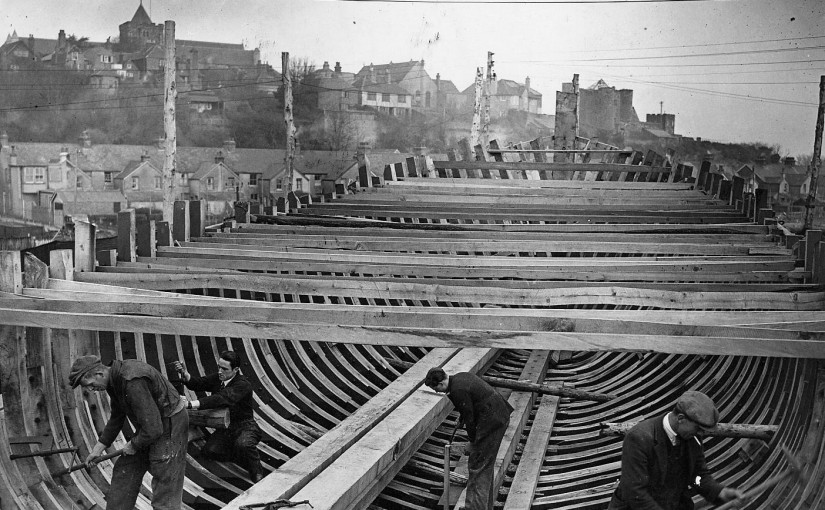The Warship Revival
Photographs from the collection of E.G. Pollington (nee Jempson)
“A Thirteenth Century traveller from inland, making his way through the gloom of the Sussex forests, might well have paused on the outskirts of Rye to listen to a strange sound, a rhythmic hammering, half-metallic, half wooden in its timbre, which floated out hour after hour on the southerly breeze. It was the sound of the caulking mallet striking the iron as the shipwrights of Rye made waterproof the seams of the vessels they had built, by filling them with a caulking of cattle hair. If you went to Rye and stood by the banks of the tiny, shallow River Rother, now the towns only connection with the sea, you could hear, in 1945, that same beat of the caulking mallet as strands of oakum were hardened home in the hull and deck seams of sturdy motor fishing-vessels which, up to the last days of the Japanese war were being built to serve as naval auxiliaries in the Pacific.”
So wrote Martin Chisholm in 1945. He continued his article in the same vein.
“One would like to believe that the men wield mallet and adze by the side of the Rother in 1945 were the direct descendants of the shipwrights of seven hundred years ago. Proof of that would tax the most patient genealogist perhaps, but does not need proof when the sounds of the working are the same, when even the smell of the newly-sawn oak planks and frames is the same smell that rose sweetly from the ancient, original saw-pits? And even if one cannot go back without break for all that time, it is certain that the land, on which Charles Morris and Co, Marine Constructors Limited, have been building for the Admiralty, was in use as a shipyard four hundred years ago when Rye was giving birth to some of the ships which were to vanquish the Armada. And the methods of to-day are not so different either. True, there are mechanical, circular and band saws to rip in a few moments through the oaken planks and frames. But, at bottom, the job of building a wooden ship is still very much what it was. The oak frames still have to be chosen from crooks which have grown nearly to the requisite shape, so that the grain will follow sweetly round the curve of the frame when it is warn to fit. The massive planking for the hull has still to be made pliable by “cooking” for hours in a steam-box, until it can be bent like a piece of spring-steel to conform to the sweeping curves of the hull.
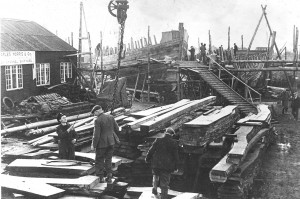
If production in this yard has not been unbroken through the centuries you can at least find in the forge a pair of bellows, doing its daily job, that was built a good hundred years ago. And the shipwrights? Many of the men at work on these motor fishing vessels have not only had long years of local ship-building themselves, but come from families who for generations have sent at least one son to the shipyards whenever there were ships building on the stocks of Rye. Is all this activity just a wartime makeshift? Are the sound of the caulking mallet and the smell of the pitch, heated to run into the seams, just a transient echo of the past? If you put that question to Captain Charles Morris, the chairman of this little band of builders of wooden ships, he will tell you of his belief that, as long as ships go to sea, there will always be scope for some vessels which have been built from the oaks which Sussex has grown since the days when men first fought and hunted in the Weald. But is he right?”
Alas, today we know the answer to that question, boats are still built at Rye but they are small and usually made of fibreglass. The old yard run by Derek Phillips will still build a clinker built vessel but few orders for these traditional Rye craft have been placed over the past ten years. The Rye yards are busy with maintenance and winter storage of pleasure boats that are prolific in Rye and Rye Harbour but the days when the town is used to build ships for the Royal Navy have surely gone forever.
So let us enjoy the contemporary newspaper reports and pictures from the Pollington scrapbook that covers the last great navel shipbuilding exploits of the shipwrights of Rye in 1944 and 1945.
Historic Launch
Not so very long ago there was a historic launch at an ancient South Coast town. It was historic not because the vessel was large or of a new type, but because it was the first launch to anything larger than an open boat for 25 years. Also, it was the first time that a ship had been built there for the Navy for a century and a half.
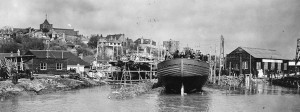
It is rather curious that while shipbuilding skill is usually something handed down from father to son, in this case it had missed a generation or two. Yet the young shipwrights in this yard can use an old-fashioned adze to shape a piece of timber and turn out as good a job as a modern machine. More than that, they can detect a timber flaw which a machine would miss.
The vessel was a 75ft motor fishing vessel, and as she went down the ways the whole town seemed to be there, especially the women and relatives of the men and boys who built her.
It was hoped that the First Lord of the Admiralty would have been there, but he was prevented by an important meeting. In his letter of apology, he referred to “this historic launching after such a long period has elapsed since the last event of its kind”. The Admiralty was represented by Mr. Charles Scott and Mr. W. H. Jago of the Naval Construction Department.
The firm is a new one and the chairman speaking after the launch, which was performed by the Mayoress said he had hopes that the revival of shipbuilding there would be permanent. Already they had had an order from a friendly foreign country for building ships after the war. He though the company was very fortunate in having as their yard foreman Mr. Jempson, affectionately known as “Percy William”.
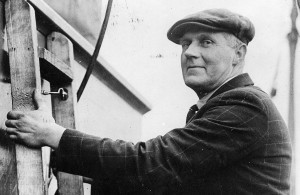
Built of Sussex Oak by Sussex Men
Motor Fishing Vessel 1063 built by Sussex men, of Sussex oak, the fourth of her class to be built at the Rock Channel Shipyard, Rye, for the Admiralty was declared entirely successful after her maiden trials at Rye on Thursday last week, and was handed over to the Admiralty runner crew for delivery to Dover on Saturday. Her final destination is at present unknown.
After fours month, during which she was undergoing fitting out and having yet engines fitted, the 1063 was ready for her trials, and on Thursday morning after the arrival of two naval lieutenants and a marine expert on board, she glided smoothly into the icy river on the coldest day of the year, with the sound of her engines scarcely perceptible. The men who built her proudly looked on from the warmth of a near-by shed.
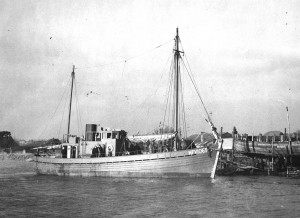
As the 1063 left, an attractive figure in slacks and a fur coat ran up the gangway to find the vessel already in mid-stream. She was Mrs. C Price, daughter of Mr C Morris, who built the ship.
Built in nine months and launched in August, last by Mrs Chris Bale, wife of the admiralty Press representative the 200 ton vessel has a length of 75 feet, a beam of 17 feet, and is powered by a Diesel Coventry Victor engine, which gives her a speed of eight or nine knots. Single-screwed, and with provision for main and mizzen sail, she is the largest yet laid in the Rock Channel yards by her builders, Charles Morris and Co and differs from the three previous ships, which were built according to the prize winning plans of Mr. Blakes ocean-going pleasure yachts, in that she has no aft saloon, and her design is entirely commercial.
Three Sister Ships
The three sister ships, which have been utilised successfully as troop carriers trawlers and mine sweepers, have seen, service in the Pacific and in Australian waters, and reached these areas, in some cases a journey of 6,000 miles, entirely under their own power and un-escorted. Their hardiness and seaworthiness are world known, and it is understood that a great overseas demand has been created for these Rye built ships.
The Mayoress (Miss F Warren) Mrs. C Morris and Mrs. C Price launched the three ships, one of which is reported to be undergoing repairs in India, and it speaks well of her builders that all have had smooth, uneventful launching, and that none has needed further adjustment or alteration.
Three further vessels of similar tonnage are laid down in the Rock Channel yard, one 80 per cent framed, and one keel laid down.
Last of War fleet launched at Rye
But Industry to continue
From the centuries-old yard at Rye on Monday the last of a fleet of six motor fishing vessels built by Messrs. Charles Morris and Co. (Marine Craft Construction), Ltd. for the Admiralty was launched by Mrs. Morris, wife of Captain C. V. Morris (chairman and managing director of the company).
The boats were built to act as fleet auxiliaries and are used for mine trawling operations. The previous vessels are in operation in the Pacific and the last M.F.V. 1064- will be in service off the British and Continental coasts.
As she christened the vessel in the traditional manner, Mrs. Morris said “I name this boat M.F.V 1064. Good luck to the ship and God bless the crew”.
Also on the platform were Mr. P. W. Jempson (works director. Mr. G. H. Bellhouse (director) and Mrs. Belhouse, and Mrs. L. B. Price (director).
The vessels have a tonnage of 120, are 75ft long and have a 19ft beam. They are propelled by 150 hp Diesel motors and are protected against magnetic mines. A hundred Sussex oak trees were used in the construction of each vessel. They have been completely fitted out in the yard.
Part of Pacific Fleet
Those sent to the Pacific reached that area-some 6,000 miles away-under their own power. They formed part of Admiral Sir Bruce Fraser’s Pacific Fleet which helped to beat the Japanese.
Captain Morris told the Express-Herald “that the boats had never developed any defects and were popular with their crews. The company anticipated building similar vessels to assist in the replacement of tonnage in the fishing fleets.
Work had already started on another fishing boat for the Admiralty, but the order had been cancelled. It might however be completed for private use. The 1064 is the last Admiralty vessel of its type to be launched from any shipyard in the country.”
During the war the Charles Morris Company revived the shipbuilding business in Rye. It had been almost dormant for the 20 years between the wars.
The Rock Channel yard employs 75 men, all of whom are local. Many claim to be direct descendants of the Rye shipwrights of 400 years ago. Foreman of the yard is Mr. Percy Goodsell.
On the same site where the late war fleet auxiliaries were constructed, Rye shipwrights were building ships in Sussex oak 700 years ago. These were for the British Navy of that time and for the merchant adventurers who set off from these shores in search of new lands and treasures. There were Rye boats with Lord Howard and Sir Francis Drake when they defeated the Spanish Armada, with Blake when he chased the Dutch, with Benbow and Rodney and with Nelson at the Battle of Trafalgar Rye craftsmen of to-day are proud to the tradition they carry forward.
The adze-inverted choppers are used on the construction of the boats in the yard. For the type of vessels being built it is superior to modern machinery and is the same method as was employed centuries ago.
Also being built in the yard are 35ft “Ideal Cruisers” specially constructed for rough weather. They can be adapted for fishing or luxury cruising.
The M.F.V From Rye
Last May, the “Spotlight” was turned on the new shipyard which had launched a 75-foot motor fishing vessel and brought back to an historic English town an industry which had left it many years ago.
The story has now been carried a stage further, for the same M.F.V. has been handed over and commissioned as a small but important unit of the Royal Navy.
We are permitted to reveal that the new yard is operated by Charles Morris and Co. at Rye, and that Captain C V Morris is the man responsible for the revival of shipbuilding at this place.
A representative of “Sportlight” saw part of the trials Admiralty overseas and inspectors checked up literally everything, even electric light switches and door handles. Winches were tested, anchors lowered and raised, and engines and dynamos were set in motion and studied by Admiralty experts.
Every consideration is given to the comfort and accommodation of the crew, who have electric heaters, electric fans and air conditioning plant.
These were the reports as written at the time. They demonstrate that Rye craftsmen, who inherited their skills from their forefathers, were again able to turn their hand to the old trade of shipbuilding in the time of their country’s need.
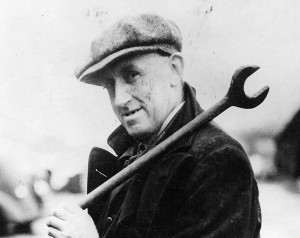
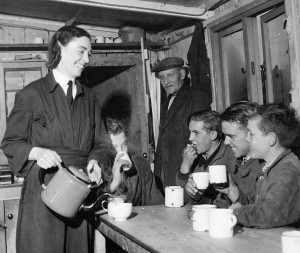
After the War most reverted to their former jobs as builders and carpenters. A few stayed on to build pleasure and fishing boats, keeping the age old skills alive. It is doubtful if Rye will be called on again to build ships of war but should the need arise the call would no doubt be answered.
First published in “Rye’s Own” August 2004
